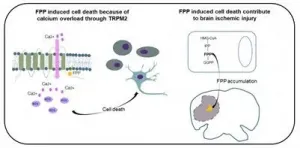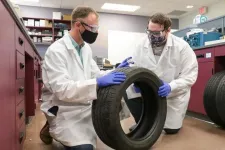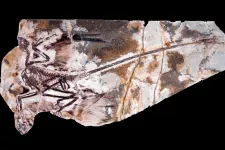Structure gives insight into how plants keep their "mouths" shut
2021-04-26
(Press-News.org) Stomata, formed by a pair of kidney-shaped guard cells, are tiny pores in leaves. They act like mouths that plants use to "eat" and "breathe." When they open, carbon dioxide (CO2) enters the plant for photosynthesis and oxygen (O2) is released into the atmosphere. At the same time as gases pass in and out, a great deal of water also evaporates through the same pores by way of transpiration.
These "mouths" close in response to environmental stimuli such as high CO2 levels, ozone, drought and microbe invasion. The protein responsible for closing these "mouths" is an anion channel, called SLAC1, which moves negatively charged ions across the guard cell membrane to reduce turgor pressure. Low pressure causes the guard cells to collapse and subsequently the stomatal pore to close down.
As part of a collaborative effort with scientists at Columbia University, researchers at the Institute of Genetics and Developmental Biology of the Chinese Academy of Sciences (CAS) have uncovered the atomic structure of SLAC1 using single particle cryo-electron microscopy (cryo-EM). This structure shows that SLAC1 channel is normally in a closed state, with two spring-loaded phenylalanyl residues in strained conformations that block the pore and prevent anions from passing through them.
Environmental factors affect channel activity by controlling SLAC1 phosphorylation. By using a two-electrode voltage clamp technique, the scientists discovered multiple "on" switches in the SLAC1 channel. When phosphate attaches to the channel, its structure shifts and opens, allowing anions to flow freely. As a result, turgor pressure drops and the stomata close.
However, the scientists discovered by using a two-electrode voltage clamp technique that the SLAC1 channel has multiple "on" switches. These are "turned on" by environmental factors that control SLAC1 phosphorylation. Specifically, when phosphate attaches to the channel, its structure shifts and opens, allowing anions to flow freely. As a result, turgor pressure drops and the stomata close."
These findings will help scientists understand how plants respond to the environmental changes facing our planet, such as drought and escalating levels of CO2 and ozone. Deep insight into the mechanism of SLAC1 control of stomatal pores will be valuable for designing drought-tolerant or water-efficient plant cultivation.
INFORMATION:
This work, entitled "Structure and activity of SLAC1 channels for stomatal signaling in leaves," was published in PNAS on April 26. It was funded by the National Key R&D Program of China, the National Natural Science Foundation of China, and the Strategic Priority Research Program of CAS.
[Attachments] See images for this press release:

ELSE PRESS RELEASES FROM THIS DATE:
2021-04-26
(Boston)--Lung carcinomas are the leading cause of cancer-related deaths in the United States and worldwide. Lung squamous cell carcinomas (non-small cell lung cancers that arise in the bronchi of the lungs and make up approximately 30 percent of all lung cancers) are poorly understood, particularly with respect to the cell type and signals that contribute to disease onset.
According to the researchers, treatments for lung squamous cell carcinomas are limited and research into the etiology of the disease is required to create new ways to treat it.
"Our study offers insight into how damage ...
2021-04-26
A multi-institutional team of researchers has identified both the genetic abnormalities that drive pre-cancer cells into becoming an invasive type of head and neck cancer and patients who are least likely to respond to immunotherapy.
"Through a series of surprises, we followed clues that focused more and more tightly on specific genetic imbalances and their role in the effects of specific immune components in tumor development," said co-principal investigator Webster Cavenee, PhD, Distinguished Professor Emeritus at University of California San Diego School of Medicine.
"The genetic ...
2021-04-26
A vital intermediate in normal cell metabolism is also, in the right context, a trigger for cell death, according to a new study from Wanli Liu and Yonghui Zhang of Tsinghua University, and Yong Zhang of Peking University in Beijing, publishing 26th April 2021 in the open access journal PLOS biology. The discovery may contribute to a better understanding of the damage caused by stroke, and may offer a new drug target to reduce that damage.
Farnesyl pyrophosphate (FPP) is an intermediate in the mevalonate pathway, a series of biochemical reactions in every cell that contributes to protein synthesis, energy production, and construction of cell membranes. During a search for regulators of immune cell function, the authors unexpectedly discovered that FPP, when present at high concentrations ...
2021-04-26
Patients hospitalized with COVID-19 may be at risk of developing heart failure even if they do not have a previous history of heart disease or cardiovascular risk factors, a new Mount Sinai study shows.
Researchers say that while these instances are rare, doctors should be aware of this potential complication. The study, published in the April 26 online issue of the Journal of the American College of Cardiology, may prompt more monitoring of heart failure symptoms among patients hospitalized with COVID-19.
"This is one of the largest studies to date to specifically capture instances of new heart failure diagnosis among patients hospitalized ...
2021-04-26
Skid marks left by cars are often analyzed for their impression patterns, but they often don't provide enough information to identify a specific vehicle. UCF Chemistry Associate Professor Matthieu Baudelet and his forensics team at the National Center for Forensic Science, which was established at UCF in 1997, may have just unlocked a new way to collect evidence from those skid marks.
The team recently published a study in the journal Applied Spectroscopy that details how they are classifying the chemical profile of tires to link vehicles back to potential crime ...
2021-04-26
A genome by itself is like a recipe without a chef - full of important information, but in need of interpretation. So, even though we have sequenced genomes of our nearest extinct relatives - the Neanderthals and the Denisovans - there remain many unknowns regarding how differences in our genomes actually lead to differences in physical traits.
"When we're looking at archaic genomes, we don't have all the layers and marks that we usually have in samples from present-day individuals that help us interpret regulation in the genome, like RNA or cell structure," said David Gokhman, a postdoctoral fellow in biology at Stanford University.
"We ...
2021-04-26
Gossip is often considered socially taboo and dismissed for its negative tone, but a Dartmouth study illustrates some of its merits. Gossip facilitates social connection and enables learning about the world indirectly through other people's experiences.
Gossip is not necessarily spreading rumors or saying bad things about other people but can include small talk in-person or online, such as having a private chat during a Zoom meeting. Prior research has found that approximately 14% of people's daily conversations are gossip, and primarily neutral in tone.
"Gossip is ...
2021-04-26
Powered flight in animals -that uses flapping wings to generate thrust- is a very energetically demanding mode of locomotion that requires many anatomical and physiological adaptations. In fact, the capability to develop it has only appeared four times in the evolutionary history of animals: on insects, pterosaurs, birds and bats.
A research paper published in 2020 in the scientific journal Current Biology concluded that, apart from birds -the only living descendants of dinosaurs-, powered flight would have originated independently in other three groups of dinosaurs. A conclusion that makes a great impact, as it increases the number of vertebrates that would have developed this costly mode of locomotion, ...
2021-04-26
A major hurdle to developing new and effective treatments for drug addiction is better understanding how exactly it manifests itself before, during and after chronic use. In a paper published online in the April 21, 2021 issue of the journal eNeuro, an international team of researchers led by scientists at University of California San Diego School of Medicine describe the creation of two unique collections of more than 20,000 biological samples collected from laboratory rats before, during and after chronic use of cocaine and oxycodone.
Developed by the Preclinical Addiction Research Consortium, located in the Department of Psychiatry at UC San Diego School of Medicine and at Skaggs School of Pharmacy ...
2021-04-26
Corn is America's top agricultural crop, and also one of its most wasteful. About half the harvest--stalks, leaves, husks, and cobs-- remains as waste after the kernels have been stripped from the cobs. These leftovers, known as corn stover, have few commercial or industrial uses aside from burning. A new paper by engineers at UC Riverside describes an energy-efficient way to put corn stover back into the economy by transforming it into activated carbon for use in water treatment.
Activated carbon, also called activated charcoal, is charred biological material that has been treated to create millions of microscopic pores that increase how much the material can absorb. It has many industrial ...
LAST 30 PRESS RELEASES:
[Press-News.org] Structure gives insight into how plants keep their "mouths" shut



